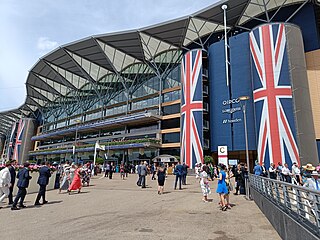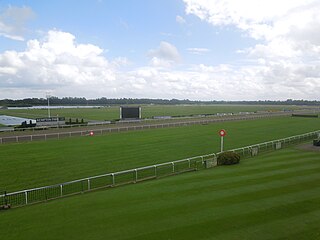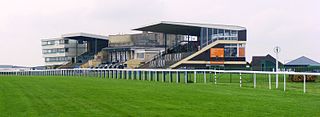
Goodwood Racecourse is a horse-racing track five miles north of Chichester, West Sussex, in England controlled by the family of the Duke of Richmond, whose seat is nearby Goodwood House. It hosts the annual Glorious Goodwood meeting in late July and early August, which is one of the highlights of the British flat racing calendar, and is home to three of the UK's 36 annual Group 1 flat races, the Sussex Stakes, the Goodwood Cup and the Nassau Stakes. Although the race meeting has become known as 'Glorious Goodwood', it is sponsored by Qatar and officially called the 'Qatar Goodwood Festival'.

Ascot Racecourse is a dual-purpose British racecourse, located in Ascot, Berkshire, England, about 25 miles west of London. Ascot is used for thoroughbred horse racing, and it hosts 13 of Britain's 36 annual Flat Group 1 horse races and three Grade 1 Jumps races.

Aintree Racecourse is a racecourse in Aintree, Metropolitan Borough of Sefton, Merseyside, England, bordering the city of Liverpool. The racecourse is the venue for the Grand National steeplechase, which takes place annually in April over three days. Aintree also holds meetings in May and June, October (Sunday), November and December.

York Racecourse is a horse racing venue in York, North Yorkshire, England. It is the third biggest racecourse in Britain in terms of total prize money offered, and second behind Ascot in prize money offered per meeting. It attracts around 350,000 racegoers per year and stages three of the UK's 36 annual Group 1 races – the Juddmonte International Stakes, the Nunthorpe Stakes and the Yorkshire Oaks.

Newmarket Racecourse is a British Thoroughbred horse racing venue in Newmarket, Suffolk, comprising two individual racecourses: the Rowley Mile and the July Course. Newmarket is often referred to as the headquarters of British horseracing and is home to the largest cluster of training yards in the country and many key horse racing organisations, including Tattersalls, the National Horseracing Museum and the National Stud. Newmarket hosts two of the country's five Classic Races – the 1,000 Guineas and 2,000 Guineas, and numerous other Group races. In total, it hosts 9 of British racing's 36 annual Group 1 races.

Moulsey Hurst is in West Molesey, Surrey on the south bank of the River Thames above Molesey Lock. It is one of England's oldest sporting venues and was used in the 18th and 19th centuries for cricket, prizefighting and other sports. This area is now called Hurst Park; the area currently called Molesey Hurst is smaller, and some 500m to the south.

Kempton Park Racecourse is a horse racing track together with a licensed entertainment and conference venue in Sunbury-on-Thames, Surrey, England, near the border with Greater London; it is 16 miles south-west of Charing Cross in central London. The site has 210 acres of flat grassland surrounded by woodland with two lakes in its centre. Its entrance borders Kempton Park railway station which was created for racegoers on a branch line from London Waterloo, via Clapham Junction.
The Long Walk Hurdle is a Grade 1 National Hunt hurdle race in Great Britain which is open to horses aged four years or older. It is run at Ascot over a distance of about 3 miles and 1 furlong, and during its running there are twelve hurdles to be jumped. The race is scheduled to take place each year in December.
Brighton Racecourse is an English horse racing venue located a mile to the northeast of the centre of Brighton, Sussex, owned by the Arena Racing Company.

Bath Racecourse is a thoroughbred horse racing venue on Lansdown Hill, about 3+1⁄4 miles (5.2 km) northeast of Bath, Somerset, England. It is owned and operated by Arena Racing Company.

Epsom Downs is a Grade 1 racecourse in a hilly area near Epsom in Surrey, England which is used for thoroughbred horse racing. The "Downs" referred to in the name are part of the North Downs.

Lincoln Racecourse is a former horse racing venue to the west of the city of Lincoln, at Carholme, a flat tract of common land in Lincolnshire, England. It was the original location of the Lincolnshire Handicap. The course closed in 1964, and the following year the race relocated to Doncaster Racecourse where a small change to the race title sees it run as the Lincoln Handicap.

Manchester Racecourse was a venue for horse racing located at a number of sites around the Manchester area including; Kersal Moor, New Barns, Weaste and Castle Irwell, Pendleton, then in Lancashire. The final home of the course, Castle Irwell, was closed in 1963. Despite its name, the course was never actually located within the boundaries of the ancient township of Manchester or the subsequent city of Manchester.

Bromford Bridge Racecourse was a racecourse in the Bromford area of Birmingham, England. Its official name was 'Birmingham'. It staged flat and national hunt racing.

Dawn Approach is an Irish Thoroughbred racehorse. In a racing career which began in March 2012 the colt has won all seven of his races including the Coventry Stakes at Royal Ascot, the National Stakes at the Curragh and the Dewhurst Stakes at Newmarket. He ended the 2012 European season as the year's most highly rated two-year-old colt and was regarded as a leading contender for the 2013 classics. As a three-year-old, Dawn Approach won the classic 2000 Guineas on his first appearance, going on to win the St James Palace Stakes at Royal Ascot.

Alexandra Park Racecourse, known to Londoners as Ally Pally, was a horse racing venue in Alexandra Park, London, England; it was colloquially known as the Frying Pan on account of its shape. It opened on 30 June 1868 and closed 102 years later on 8 September 1970. It is now incorporated into the park, with a sports pitch in the centre of the racetrack oval.

Leading Light is an Irish Thoroughbred racehorse. As a two-year-old, he was well-beaten in his first race before winning a maiden race. In 2013, he established himself as a leading stayer, winning his first four races, including the Gallinule Stakes, the Queen's Vase, and the classic St Leger Stakes. As a four-year-old, he won the Vintage Crop Stakes before winning the Ascot Gold Cup.

Night of Thunder is an Irish-bred, British-trained Thoroughbred racehorse. In May 2014, he won the 2000 Guineas. He failed to win again as a three-year-old but finished second in both the St James's Palace Stakes and the Queen Elizabeth II Stakes and third in the Prix du Moulin. On his four-year-old debut, he won the Lockinge Stakes.
The Victoria Cup is a flat handicap horse race in Great Britain open to horses aged four years or older. It is run over a distance of 7 furlongs (1,408 metres) at Ascot in May.

Harbour Law is a British Thoroughbred racehorse. Unraced as a two-year-old he showed steady improvement in 2016, winning two minor races and finishing second in the Queen's Vase before recording a 22/1 upset victory in the St Leger. In the following year he finished third in the Ascot Gold Cup but his racing career was ended by injury shortly afterwards.



















